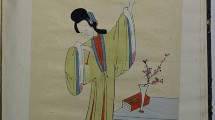Abstract
Despite geographical distance and cultural dissimilarity, the European and Chinese sides of the early modern debate over what constitutes “fine art” start from similar premises and arrive at similar conclusions. Europeans concluded that Chinese painting should only be regarded, at best, as decorative art and never as “fine art”—and so has no place in the tradition of the grand masters, and Chinese concluded that European painting, despite its technical mastery of the secrets of visual illusion, should only be regarded as illustration and so belongs to the craft of painting and not the tradition of fine art in China, the tradition of scholar or literati painting—their version of le grand gout “grand taste.” The inability to see with different eyes or to judge except in terms of one’s own cultural and aesthetic standards, the lack of trans-cultural objectivity, all these mark both the European and the Chinese mentality of the seventeenth and eighteenth centuries. Prisoners in their own cultures, each side could only think as they did. The mutual enrichment that did occur despite such limitations of taste and judgment happened on the peripheries of art and not at its core—Chinese painting added significantly to European notions of decoration and design, and European painting added significantly to the art of illustration in China, all while leaving basic standards and assumptions intact. With the confluence of decorative and fine art in Europe during the nineteenth century and with the confluence of the popular crafts and the tradition of literati painting in China during the later nineteenth and early twentieth centuries in China, the dichotomies that so marked earlier eras began to fail, to be replaced by increasing sensitivity on both sides to the possibilities of creating new visions, new expressions, new techniques, through the amalgamation and fusion of differences.
Similar content being viewed by others
Notes
Shaoshu (1890).
Chaves’s Singing of the Source: Nature and God in the Poetry of the Chinese Painter Wu Li (1993) is an excellent introduction to Wu Li’s life, intellectual world, and poetry, but it says little about Wu as a painter, and, unfortunately nothing about his attitude to European art. The few things said about Wu as a painter takes it for granted that he was very fine but typical late traditional literati artist.
Although there seems no doubt about this, it would have been interesting to know why Professor Chaves thought he was not influenced by Western art.
Li (1632–1718).
Sullivan (1973, p. 62).
Fang, H. 方豪, “Wu Yushan xiansheng Sanyuji jiaoshi 吳漁山先生『 三餘集 』校釋 (Collations and annotations to Mr. Wu Yushan’s Collected Poems Composed During Three Kinds of Spare Time [winter, night, rainy days]), 99–100, contained in Zhou (1971).
Li (1632–1718, 5:88b).
Zou Yigui 鄒一桂, Xiaoshan huapu 小山畫譜 (Studies of Painting and Painters by Xiaoshan) (Congshu jicheng chubian 叢書集成初編 ed.), B:43. Zou’s work has been translated in its entirety in Debon and Chou (1969).
Sullivan (1973, pp. 63–70).
Zhao (1977, Reprint 1994).
Sullivan (1973, pp. 165–196).
Quoted in Belevitch-Stankevitch (1910).
Quoted in translation in Sullivan (1973, p. 48).
Nieuhof (1669).
de Mailla (1785).
Reichwein (1925).
Sonnerat (1782).
References
Belevitch-Stankevitch, H. (1910). Le Goût chinoise en France au temps de Louis XIV. Paris: Jouve.
Chaves, J. (1993). Singing of the source: Nature and God in the poetry of the Chinese Painter Wu Li. Honolulu, HI: University of Hawaii Press.
de Mailla, J. A. (1785). Histoire generale de la Chine ou annales de cet empire, traduit du texte chinois (Vol. 3, p. 782). Paris: Pierres, Clousier.
Debon, G., & Chou, C. (1969). Lob der Naturtreue des Tsou I-Kuei (1686–1772). Wiesbaden: Harrassowitz.
Feifel, E. (1938). Wu Yü-Shan. Monumenta Serica, 3(1), 169.
le Comte, L. (1699). Das heutige Sina (Vol. 1, p. 309). Frankfort: Christoph Riegel.
Li, W. (1632–1718). Mojing ji 墨井集 (Ink Well Collection). Shanghai: Tushanwan yinshuguan 土山灣印書館 (Vol. 4, pp. 72b–73a) (1909 moveable type edition).
Mendoza, J. (1589). Histoire du grand royaume, de la Chine situé aux Indes Orientales (p. 169). Rome: Ieremie Perier.
Nieuhof, J. (1669). An embassy from the East-India Company of the United Provinces (pp. 165–166). London: John Ogisby.
Pottier, E. (1890). Grèce et Japon. Gazette des beaux-arts, 4, 105.
Reichwein, A. (1925). China and Europe: Intellectual and artistic contacts in the eighteenth century (pp. 25–72). New York: Alfred A. Knopf.
Semedo, A. (1667). Histoire universelle de la Chine (Vol. 2, p. 84). Paris: Hierosme Prost.
Shaoshu, J. (1890). Wushengshi shi 無聲詩史 (History of Silent Poetry) (Vol. 7, 19a). Xinhui 新會: Liushi Zangxiutang shuwu 劉氏藏修書屋.
Sonnerat, M. (1782). Voyage aux Indes orientales et à la Chine (Vol. 2, pp. 261–262). Paris: Froule.
Sullivan, M. (1973). The meeting of eastern and western art: From the sixteenth century to the present day. London: Thames and Hudson.
Voltaire, F. M. A. (1756). Essai sur les Moeurs (Chapitre 142). Genève: Cramer.
Yuan, C. (1936). Wu Yushan jinduo erbai wushi nian jinian 吳漁山先生晉鐸二百五十年紀念 (In commemoration of the two hundred fiftieth anniversary of the ordination of Wu Yushan), Furen xuezhi 輔仁學志 (Fu Jen Hsüeh-Chih Series Sinologica), 5, 1–2. (Reprinted from Wu Yushan (Li) yanjiu lunji 吳漁山(歷)研究論集 (Research articles on Wu Yushan (Li), pp. 35–57, by K. Zhou, Ed., 1971, Hong Kong: Chongwen shudian.)
Zhao, E., et al. (Eds.). (1977/1994). Qingshigao 清史稿 (Draft history of the Qing Era) (Beijing: Zhonghua shuju, 1977; Reprint 1994), 46:504:13911.
Zhou, K. (Ed.). (1971). Wu Yushan (Li) yanjiu lunji 吳漁山(歷)研究論集 (Research articles on Wu Yushan (Li) (pp. 85–102). Hong Kong: Chongwen shudian.
Author information
Authors and Affiliations
Corresponding author
Rights and permissions
About this article
Cite this article
Lynn, R.J. The reception of European art in China and Chinese art in Europe from the late sixteenth through the eighteenth century. Int. Commun. Chin. Cult 4, 443–456 (2017). https://doi.org/10.1007/s40636-016-0067-9
Received:
Accepted:
Published:
Issue Date:
DOI: https://doi.org/10.1007/s40636-016-0067-9




